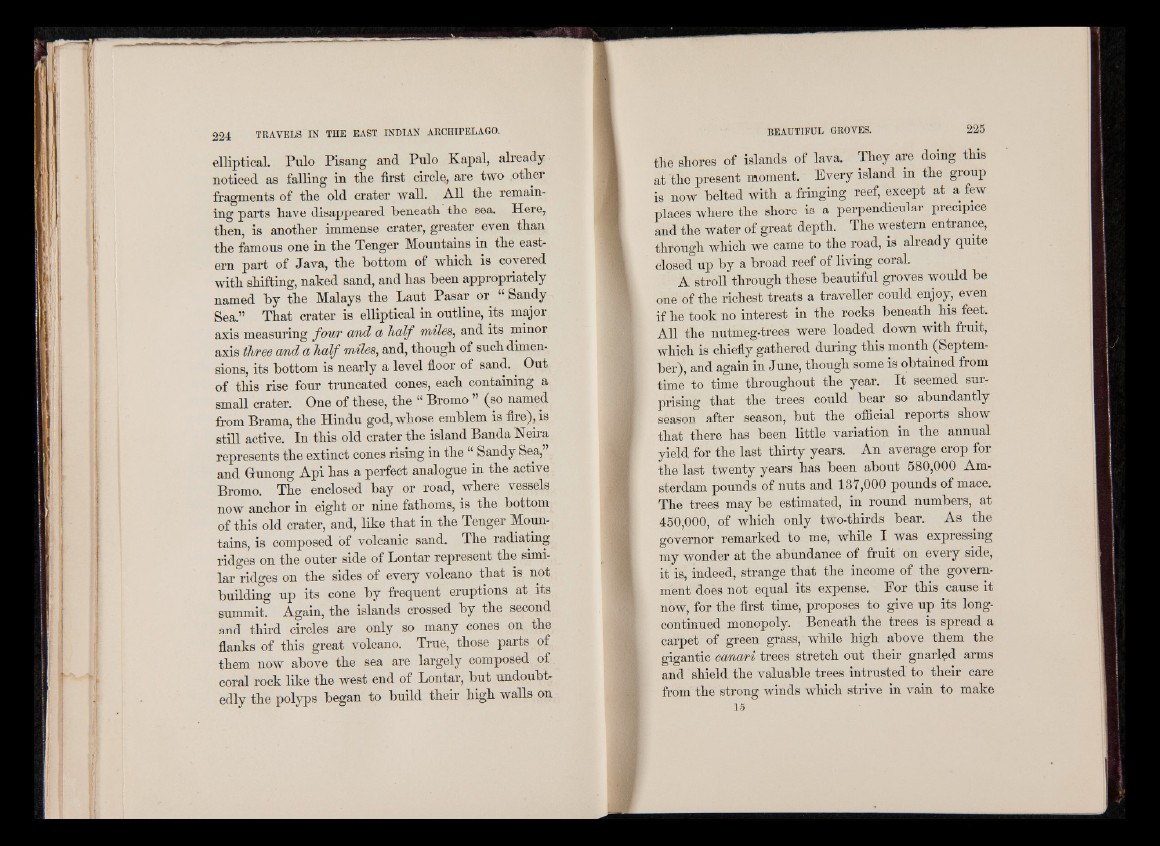
elliptical. Pulo Pisang and Pulo Kapal, already
noticed as falling in tlie first circle, are two other
fragments of the old crater wall. All the remaining
parts have disappeared beneath the sea. Here,
then, is another immense crater, greater even than
the famous one in the Tenger Mountains in the eastern
part of Java, the bottom of which is covered
with shifting, naked sand, and has been appropriately
named by the Malays the Laut Pasar or Sandy
Sea.” That crater is elliptical in outline, its major
axis measuring fowr ct/ud a half miles, and its minor
aria th/ree a/nd a half miles, and, though of such dimensions,
its bottom is nearly a level floor of sand. Out
of this rise four truncated cones, each containing a
small crater. One of these, the “ Bromo ” (so named
from Brama, the Hindu god, whose emblem is fire), is
still active. In this old crater the island Banda Neira
represents the extinct cones rising in the u Sandy Sea,
and Gunong Api has a perfect analogue in the active
Bromo. The enclosed bay or road, where vessels
now anchor in eight or nine fathoms, is the bottom
of this old crater, and, like that in the Tenger Mountains,
is composed of volcanic sand. The radiating
ridges on the outer side of Lontar represent the similar
ridges on the sides of every volcano that is not
building up its cone by frequent eruptions at its
summit. Again, the islands crossed by the second
and third circles are only so many cones on the
flanks of this great volcano. True, those parts of
them now above the sea are largely composed of
coral rock like the west end of Lontar, but undoubtedly
the polyps began to build their high walls on
the shores of islands of lava. They are doing this
at the present moment. Every island in the group
is now belted with a fringing reef, except at a few
places where the shore is a perpendicular precipice
and the water of great depth. The western entrance,
through which we came to the road, is already quite
closed up by a broad reef of living coral.
A stroll through these beautiful groves would be
one of the richest treats a traveller could enjoy, even
if he took no interest in the rocks beneath his feet.
All the nutmeg-trees were loaded down with fruit,
which is chiefly gathered during this month (September),
and again in June, though some is obtained from
time to time throughout the year. It seemed surprising
that the trees could bear so abundantly
season after season, but the official reports show
that there has been little variation in the annual
yield for the last thirty years. An average crop for
the last twenty years has been about 580,000 Amsterdam
pounds of nuts and 137,000 pounds of mace.
The trees may be estimated, in round numbers, at
450,000, of which only two-thirds bear. As the
governor remarked to me, while I was expressing
my wonder at the abundance of fruit on every side,
it is, indeed, strange that the income of the government
does not equal its expense. For this cause it
now, for the first time, proposes to give up its long-
continued monopoly. Beneath the trees is spread a
carpet of green grass, while high above them the
gigantic canari trees stretch out their gnarled arms
and shield the valuable trees intrusted to their care
from the strong winds which strive in vain to make
15